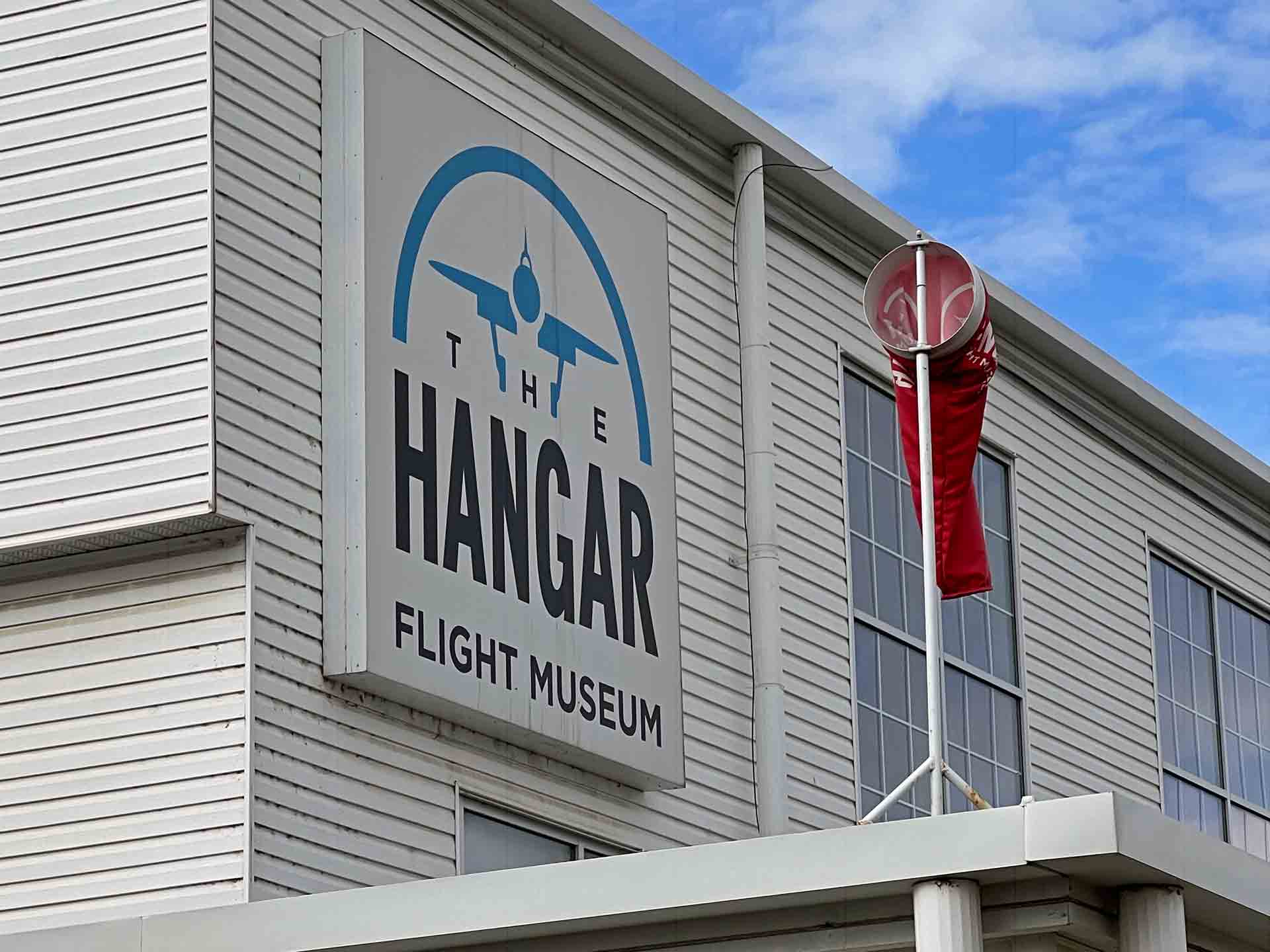The nucleus of Canada’s aviation
The rise of Canada and Calgary as a Western center is closely tied to the development of aviation. Churning out fresh pilots during the Second World War, the old drill hall has become a fascinating museum in 1985, boasting an exquisite collection of airframes mostly from domestic production.
Canada is the world’s second-largest country with endless empty spaces – and very few people. Europe in contrast is home to over 450 million inhabitants living in an area not even half as vast as Canada, where in turn 40 million people settle in an area of more than double the size as Europe. Alberta province alone is twice the size of Germany, but only home to four and a half million people, of which one and a half million each reside in Calgary and Edmonton. Anyone who wants to travel from here to any other big city in the country has to fly – or needs to spend endless days in a car, as there are no intercity passenger train or bus links. “You come to Calgary either by aircraft – or not at all,” says the German CEO of Calgary-based WestJet, Alexis von Hoensbroech.
Hangar with a history: The building housing the Hangar flight museum was erected in 1941 as part of the Commonwealth war effort. Under the same roof that today houses legendary civil and military aircraft with a Canadian connection, a total of 804 war pilots received their training until 1944.
Canada and flying is a symbiosis, more than in any other country on the globe. And Calgary’s airport has a huge footprint, as everything else here. To reach the Hangar Flight Museum in the south of the perimeter means traveling by car for over 10 km alongside the longest runway in all of Canada, stretching for 4.2 km. But this deters nobody – in 2022 the museum had 37,000 visitors.
Hangar with history
The long, white hangar, which became first the venue of the then Aero Space Museum of Calgary in 1985, was erected in 1941 on the edge of the new airport in the city, opened only three years before. It was part of the concerted efforts of Commonwealth countries in the Second World War, Canada’s role at the time was to provide as many new pilots as possible to serve in the British-led Commonwealth air forces. Until 1944 a total of 804 new pilots received their wings here. One of the instructors between 1942 and 1944 was someone whose granddaughter rose to highest fame today: Commander Peter Middleton, grandfather of the future Queen of England, Kate Middleton, Princess of Wales. After the war, the Canadian Air Force moved in, later a helicopter company. It was the fledgling Canadian airline industry which now had most to gain from the surplus of aircraft and personnel – and so for example Canadian Pacific Airways was founded, later becoming part of Air Canada. Since 2016 the museum is named The Hangar Flight Museum, and next to its main building, the hangar, there now is an annex with a tented roof to shelter more exhibited aircraft.
Bush flying in Canada would be unthinkable without the legendary Douglas DC-3. The aircraft on display in the tent hangar bears serial number 13448 and made its way into Canada in 1956 after having flown in the US for about a decade. Initially it operated supply flights for a pipeline company. In 1967 the DC-3 was transferred to Yellowknife in the far north and flew for different airlines, last with the famous ice pilots of Buffalo Airways.
The legendary Twin Otter
There is no Canadian aircraft better known around the world, as significant and long-lasting as the indestructible de Havilland Canada DHC-6 Twin Otter. This robust turboprop twin for usually 19 passengers was produced between 1965 and 1988 and again since 2008 until this day, in total almost a thousand aircraft so far. Its most extraordinary feature is its extreme STOL capability: “Without payload it could take off within the space of our tented hangar,” explains one of the volunteers offering guided tours in the museum to stunned visitors. For whom the sidewalls now appear not far apart any more at all, at least imagining an aircraft to take off in between them. The aircraft is painted in the livery of Kenn Borek Air, an equally legendary Canadian operator whose hangar is suitably just the next one down at Calgary airport. It’s here they work on a multitude of Twin Otters that are leased out globally to fly under often extreme conditions. Mostly for scientific missions and oil or gas exploration, but also in tourism and supply deliveries, these Twin Otters operate in the Arctic and in Antarctica equally well as linking tropical archipelagos with ultra-short runways. The museum aircraft is a record holder, was built as a pre-production model already in 1966, flew until 1997 and landed at the North Pole once. Most significantly, it spent as long in the air as no sister aircraft ever in her over 30 years of service: A total of 25,503 flight hours – equalling almost three years of solid time aloft.
Bush plane and early airliner
Even to many experts, the Barkley-Grow T8P-1 will sound unfamiliar, as there were just eleven built from 1937 by its manufacturer in Detroit. What made the six-seater (plus two crew) perfect for Canada was the fact that the all-metal, low-wing monoplane with heated cabin could operate on wheels, skies or floats, depending on the season. In 1939 a Barkley-Grow performed the first non-stop flight from New York to Lima, another one took polar explorer Richard Byrd on his third Antarctic expedition in 1939/1940. Just three of these rare bush-planes and early airliners have survived, and all are found in Alberta. The museum aircraft displayed in the tented hangar on floats was built in 1940 and was Canada’s first airliner operated by uniformed crews, even had a flight attendant on some routes. This aircraft served no less than six smaller to medium-sized airlines, two of them later rising to rank among the largest carriers in all of Canada, Pacific Western und Canadian Pacific Airlines.
Rare pioneer from the late thirties: The elegant Barkley-Grow T8P-1 still appears timelessly elegant even in the ninth decade of its existence. The aircraft was incredibly versatile, perfect for the always harsh, contantly changing conditions in Canada. The museum aircraft, built 1940, last flew in 1979.
Big airlines from Western Canada
Two airlines with national significance are or were from Calgary. One of them Canadian Airlines, having flown under this name from 1987 to 2001 before being taken over by Air Canada. The other one is WestJet, which started in 1996 in Calgary as a low-cost carrier. Today it is Canada’s number two, operating about 140 Boeing 737s and seven Boeing 787s, linking its base with destinations from Tokyo to Paris. In the Hangar Museum both are present, Canadian with a look-through model of a DC-10, WestJet with the cabin trainer of its former Boeing 767 pioneering transatlantic services in 2015.
No other aircraft stands as a symbol for Canada as much as the Twin Otter. Kenn Borek Air, whose livery it shows here, has its base in the neighboring hangar and operates Twin Otters globally, from the Poles to the Maldives. Also Viking Air, which took up production again in 2008, has one of its facilities in Calgary. The aircraft displayed in the tent hangar was built in 1966 and flew as much as no other.
Text und photos: Andreas Spaeth
Information
The Hangar Flight Museum is located on the southern end of the airport in Calgary, 4629 McCall Way NE.
Open daily except Monday 10am to 4pm, entry for adults 15 Canadian Dollars
www.thehangarmuseum.ca
















